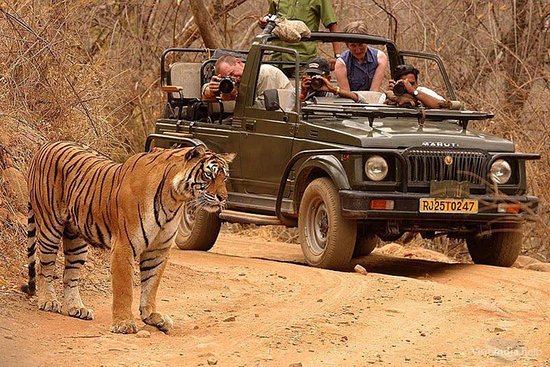Wildlife Adventures Begin Here
Ranthambore National Park
Welcome to Ranthambore National Park

Ranthambore Tiger Reserve holds a prestigious place in India’s wildlife tourism, known for its raw natural beauty, rich biodiversity, and especially the Royal Bengal Tigers that freely roam its forests. While it may not be the largest national park in the country, it is undoubtedly one of the most popular and visited wildlife destinations in India — attracting nature lovers, wildlife photographers, and adventure seekers from all over the world.
Nestled between the Aravalli Hills and the Vindhya Plateau, Ranthambore covers a vast forest area of 1,334 sq km, with 392 sq km designated as the core national park zone. The park is renowned for offering one of the highest chances of spotting tigers during daytime safaris, making it a top destination for Ranthambore jeep safari bookings and canter safari bookings.
Book Your Ranthambore Holiday Today!
Services we offer in Ranthambore National Park

Ranthambore Sanctuary

Tour Packages

Hotel Booking

Chambal Safari Booking
Ranthambore Safari Booking & Travel Info

Safari Zones

Gypsy Safari

Safari Timing

Animals
Ranthambore Safari Ticket Prices 2025-26
Jeep Safari Price
Jeep safaris are a popular way to explore Ranthambore Tiger Reserve. Each Jeep can comfortably seat up to 6 passengers. A one-zone permit allows you to enjoy a 3.5-hour safari, available in both morning and afternoon shifts, covering any zone from 1 to 10.
For Indian tourists: ₹1,350 per person per safari (government price, excluding service charge and GST)
For foreign tourists: ₹2,500 per person per safari (government price, excluding service charge and GST)
Canter Safari Price
Canter safaris are a budget-friendly option for wildlife lovers. These open-roof canters can accommodate up to 20 passengers. The one-zone permit for Canter Safari also lasts 3.5 hours, available in morning and afternoon shifts, and covers any zone from 1 to 10.
- For Indian tourists: ₹815 per person per safari (government price, excluding service charge and GST)
- For foreign tourists: ₹2,000 per person per safari (government price, excluding service charge and GST)
Ranthambore Jungle Safari Timings
Safari timings at Ranthambore Sanctuary change with the seasons, so it’s best to check the schedule before planning your visit. Below are the usual timings for morning and evening safaris throughout the year:
| Month | Morning Safari | Evening Safari |
|---|---|---|
| 1st Oct to 31st Oct | 6:30 AM – 10:00 AM | 2:30 PM – 6:00 PM |
| 1st Nov to 31st Jan | 7:00 AM – 10:30 AM | 2:00 PM – 5:30 PM |
| 1st Feb to 31st March | 6:30 AM – 10:00 AM | 2:30 PM – 6:00 PM |
| 1st April to 15th May | 6:00 AM – 9:30 AM | 3:00 PM – 6:30 PM |
| 16th May to 30th June | 6:00 AM – 9:30 AM | 3:30 PM – 7:00 PM |
How to Plan Ranthambore Tour
Planning a Ranthambore tour is an exciting journey for nature lovers and wildlife enthusiasts. To enjoy a smooth and memorable experience, here’s everything you need to know in one easy-to-understand guide:
The best time to visit Ranthambore National Park is from October to June, when the chances of spotting Royal Bengal Tigers are highest. Remember, Zones 1 to 5 remain closed during monsoon (July to September), while Zones 6 to 10 stay open even during the rainy season.
Book your hotel or resort early, as Ranthambore gets a lot of visitors in peak seasons. From budget stays to luxury jungle lodges, you’ll find many options near Sawai Madhopur, close to the safari entry gates.
For safaris, the park offers two choices:
Jeep Safari (6-seater) – Great for close views and wildlife photography
Canter Safari (20-seater) – Best for groups and budget travellers
Safari permits are mandatory and must be booked online or through registered tour agents. Each vehicle comes with a licensed nature guide, who helps you understand the park and spot wildlife safely
Nearby places or cities
About 270 km away, Agra is world-renowned for the Taj Mahal, one of the Seven Wonders of the World. This beautiful white marble monument symbolizes love and is a UNESCO World Heritage Site. Besides the Taj, explore Agra Fort and Mehtab Bagh. Adding Agra to your Ranthambore trip brings a historical and romantic touch to your journey.
Located just 180 km from Ranthambore, Jaipur is a must-visit for anyone exploring Rajasthan. Known as the Pink City, Jaipur is famous for its majestic forts, palaces, and traditional markets. Visit Amber Fort, City Palace, and Hawa Mahal, or shop for handicrafts and jewelry in the vibrant bazaars. It's a great cultural stop either before or after your Ranthambore jungle safari.
Located around 200 km from Ranthambore, Bharatpur is home to the Keoladeo National Park, a UNESCO-listed bird sanctuary. It's a haven for bird lovers, especially during the winter months when migratory birds like Siberian cranes, pelicans, and flamingos flock here. Enjoy peaceful nature walks and rickshaw rides through this lush wetland sanctuary.
About 400 km from Ranthambore, Delhi is a vibrant mix of old and new India. Explore iconic landmarks like the Red Fort, Qutub Minar, India Gate, and Lotus Temple. Indulge in street food, shop in local markets, or enjoy modern cafes and malls. Delhi is well-connected by air and rail, making it a convenient entry or exit point for your Ranthambore wildlife tour.
Flora and Fauna of Ranthambore National Park Rajasthan India
Ranthambore National Park is not just about tigers — it’s a vibrant ecosystem full of diverse plants, birds, and animals. The park is located on the edge of the Thar Desert, so the climate is mostly dry, which gives rise to its dry deciduous forests.
Flora (Plant Life)
Ranthambore has around 300 species of plants, most of which are well adapted to dry conditions. The landscape includes rocky hills, open grassy meadows, lakes, plateaus, and narrow valleys, all of which support different plant communities.
The most common tree you’ll spot is the Dhok tree (Anogeissus pendula), which covers large parts of the forest.
Other plants like banyan trees, pipal, neem, and acacia also thrive here, adding to the greenery.
Fauna (Wildlife)
Ranthambore is home to a wide range of wild animals, making it one of the top wildlife destinations in India.
Of course, the Royal Bengal Tiger is the star of the park, and spotting one in the wild is an unforgettable experience.
Alongside tigers, you can also find leopards, jackals, caracals, jungle cats, and hyenas.
Large herbivores like sambars, chitals (spotted deer), nilgai (blue bull), wild boars, and chinkaras are commonly seen grazing in the open fields.
The park is also rich in birdlife, with over 300 species of birds including peacocks, parakeets, treepies, owls, eagles, and kingfishers, making it a paradise for bird watchers.
The lakes and water bodies attract crocodiles, turtles, and various water birds throughout the year.
How to Plan Ranthambore Tour
The best time to visit Ranthambore National Park is from October to June. During October to March, the weather is pleasant, and the forest is lush, making it ideal for spotting a variety of wildlife and enjoying birdwatching. If you’re mainly interested in seeing tigers, April to June is the best period, as the heat draws animals to water sources, increasing your chances of sightings—though temperatures can rise up to 40°C, so it’s important to stay hydrated and choose early morning safaris. From July to September, the monsoon season arrives. While Zones 1 to 5 are closed, Zones 6 to 10 remain open, offering a greener, quieter experience with fewer crowds. This time is suitable for those who enjoy nature and want to avoid peak-season rush.

A Quick Overview of Key Information About Ranthambore
| Location | Sawai Madhopur, Rajasthan, India |
| Established | Wildlife Sanctuary in 1955, Tiger Reserve under Project Tiger in 1973, National Park in 1980. |
| Total Area | 1,334 km2 (515 sq mi) |
| Major Species Found in the Park | Royal Bengal Tigers, Leopards, Sloth Bears, Striped Hyenas, Sambar deer, Jackals, Indian Foxes, Crocodiles etc. |
| Best Time to Visit Ranthambore | October to June |
| Safari Types | Jeep & Canter Safari |
| Safari Timings | Morning & Afternoon Safari |
| Other Major Attractions Inside the Ranthambore Park | Ranthambore Fort, Trinetra Ganesha Temple & Lakes |
| Nearest Railway Station | Sawai Madhopur Railway Station |
| Nearest Airport | Jaipur International Airport |
| Safari Zones in Ranthambore | 10 Safari Zones |
| Ranthambore’s Climate | Summers (April to June) are hot and dry, winters (October to March) are pleasant |
| Bird Species Found in Ranthambore | Over 270 species of birds are found in Ranthambore |
Tourist Attraction in Ranthambore


Right at the entrance of the fort, you will find the Trinetra Ganesha Temple, a unique and sacred place for Lord Ganesha devotees. This temple is the only one in India dedicated to Trinetra Ganesha, featuring the idol of Lord Ganesha with his consorts, Riddhi and Siddhi. The temple is famous for a special tradition—thousands of devotees send invitation letters asking Lord Ganesha to bless their family’s auspicious events. Every letter is respectfully read aloud by the priests before the idol, making this temple a deeply spiritual and popular destination.
Ranthambore Fort is one of India’s ancient forts and a proud UNESCO World Heritage Site due to its rich historical importance. Located inside Ranthambore National Park, just 13 km from Sawai Madhopur railway station, this majestic fort dates back to 944 AD. It stands as a symbol of bravery and pride of the Rajput rulers who controlled this region over centuries. Throughout history, many kings fought to capture this strategic fort. During India’s independence, the fort was under the Maharaja of Jaipur, and the surrounding Ranthambore forest was the exclusive hunting ground for Jaipur’s royals.
At the edge of the tiger reserve lies the Kachida Valley, a hidden gem with stunning landscapes featuring hills, valleys, ravines, and water bodies. This peaceful and untouched wilderness is home to many wild animals, including panthers and bears. You can explore Kachida Valley only through Jeep safaris, offering an authentic experience of nature’s untouched beauty.
Another must-see is Jogi Mahal, a small palace that once served as a resting place for the Jaipur royals during their hunting trips. Located on the banks of Padam Lake inside the forest, it’s a beautiful monument surrounded by nature. Nearby stands the second-largest banyan tree in India, adding to the charm and attraction for visitors. know more about Sawai Madhopur Go To Gov Site . Ranthambore
Famous Tigers of Ranthambore
Ranthambore National Park is world-famous for its healthy population of Royal Bengal tigers, attracting thousands of wildlife lovers and photographers every year. Over time, a few tigers have become legends due to their unique personalities and remarkable stories.
Machli – The Queen of Ranthambore
Machli, born in 1997, was one of the most iconic tigers of Ranthambore. Known for her exceptional hunting skills, she once defeated a large crocodile in the park’s lake, showcasing her power and courage. Machli was also a caring mother, raising several cubs who continue her legacy in the park. She lived a long life for a wild tiger, passing away in 2016, and remains a symbol of strength and beauty.
Ustad (T-24)
Ustad was a massive and dominant male tiger known for his imposing size and fierce nature. Though powerful, he was involved in a few human attacks, which led to his relocation to a zoo in 2015. Despite his controversial reputation, Ustad remains a memorable figure in Ranthambore’s tiger history.
Sultan (T-72)
Sultan was another giant of Ranthambore, admired for his size and strength. He patrolled his territory with confidence until 2018 when he got severely injured during a fight with another tiger. Unfortunately, he passed away due to his wounds, leaving behind many memories for visitors and park officials.
Broken Tail (T-17)
Named for his distinctive broken tail, this male tiger was a popular sight in Ranthambore, often seen resting on rocks or strolling along the park roads. Sadly, Broken Tail disappeared in 2010 and was later found dead in a nearby village. His story reminds us of the challenges wild tigers face even in protected areas.
Frequently Asked Questions
1. What is the best time to visit Ranthambore National Park?
The best time to visit Ranthambore is between October and June when the weather is pleasant and the park is open for safaris.
2. How can I book a safari in Ranthambore National Park?
You can book safaris online through the official Ranthambore website or use trusted tour operators to secure your permits in advance.
3. What types of safaris are available in Ranthambore?
Ranthambore offers Jeep safaris and Canter safaris. Jeeps seat up to 6 people, while Canters are open-roofed vehicles for up to 20 passengers.
4. Is it safe to go on a safari in Ranthambore?
Yes, safaris are safe as they are guided by trained forest officials and nature guides who follow strict safety rules.
5. Are children allowed on Ranthambore safaris?
Yes, children above 5 years are allowed on safaris, but they must be accompanied by an adult.
6. What wildlife can I expect to see in Ranthambore besides tigers?
Besides tigers, you can spot leopards, deer, sloth bears, wild boars, crocodiles, and many bird species.
7. How long is a typical safari in Ranthambore National Park?
A standard safari lasts about 3.5 hours, available in morning and afternoon sessions.
8. What should I carry during a Ranthambore safari?
Carry essentials like water, binoculars, camera, sunscreen, hat, and comfortable clothing.
9. Are there accommodation options near Ranthambore National Park?
Yes, there are many hotels and resorts nearby, ranging from budget stays to luxury resorts.
10. Can I visit Ranthambore Fort during my trip?
Yes, Ranthambore Fort is located inside the park and is a popular historical attraction for visitors.
11. How early should I arrive for a Ranthambore safari?
It’s best to reach the safari gate at least 30 minutes before your scheduled safari time to complete the check-in process smoothly.
12. Can I take photographs during the safari?
Yes, photography is allowed, but avoid using drones or flash photography inside the park.
13. What’s the main difference between Jeep and Canter safaris?
Jeep safaris seat up to 6 people and offer a more personal experience, while Canter safaris seat up to 20 people and are more budget-friendly.
14. Is food available inside the park during safari?
No, food is not provided inside the park, so carry light snacks and water if needed.
15. Do I need a guide for the safari?
Yes, it is mandatory to be accompanied by a trained forest guide during your safari for safety and a better wildlife experience.
Road Distance from Ranthambore to following Cities
Distance from Delhi – 380 Km
Distance from Jaipur – 200 Km
Distance from Agra – 250 Km
Distance from Udaipur – 420 Km
Distance from Kota – 110 Km
Distance from Bharatpur – 230 Km
Distance from Ajmer – 270 Km
Ranthambore Safari Booking
- Information about each visitor: Full name, Age, Sex (as printed on the ID proof provided by you)
- Date of Booking safari & Safari timing (Morning/Afternoon)
- Specific ID card number of all visitors (Voter Id, Aadhar Card, Pan card, Driving license, etc.)
- Safari Entry fees paid in advance
- Zones 1/2/3/4/5 is Closed on Every Wednesday
- Zones 6/7/8/9/10 is Closed on Every Tuesday
Zone Highlights:
Ranthambore National Park is divided into 10 safari zones, each offering a unique wildlife experience.
Zones 1–5 are the most popular, with frequent tiger sightings and lush surroundings. Zone 3 stands out for its stunning lakes like Padam Talao and Rajbagh Lake — scenic spots where tigers are often seen roaming.
Zones 6–10 are less crowded and open during the monsoon months (July to September). These zones let you experience the park’s beauty in a more serene, green atmosphere.
To avoid last-minute hassles, it’s best to book your safari online. Reservations open 90 days in advance, giving you early access to your preferred zone and timing.
How To Reach Ranthambore
By Air:
The nearest airport is Jaipur International Airport, around 200 km away. From there, you can easily hire a taxi or private cab to reach the park.
By Train:
Sawai Madhopur Railway Station is just 14 km from the park and is well-connected to major Indian cities. Jaipur Railway Station (200 km away) is another good option.
By Road:
Ranthambore is accessible by national and state highways from Delhi, Agra, Bharatpur, Jaipur, and Udaipur. Mumbai is about 1,030 km away and best reached by a combination of flight and road/train.
Ranthambore Different Names
Ranthambore National Park
Ranthambore Tiger Reserve
Ranthambore Wildlife Sanctuary
Ranthambore Forest
Ranthambore Safari Park
Ranthambore Tiger Reserve Reviews

“Jeep Safari was thrilling!” “We booked a private jeep safari and loved every minute. The jungle is beautiful, and we even saw a leopard!”
Sohan - Ria

“Amazing Tiger Sightings!” We spotted a tiger within 15 minutes of entering Zone 3! The guide was very experienced. A must-visit park for nature lovers.”
Juliy - James
